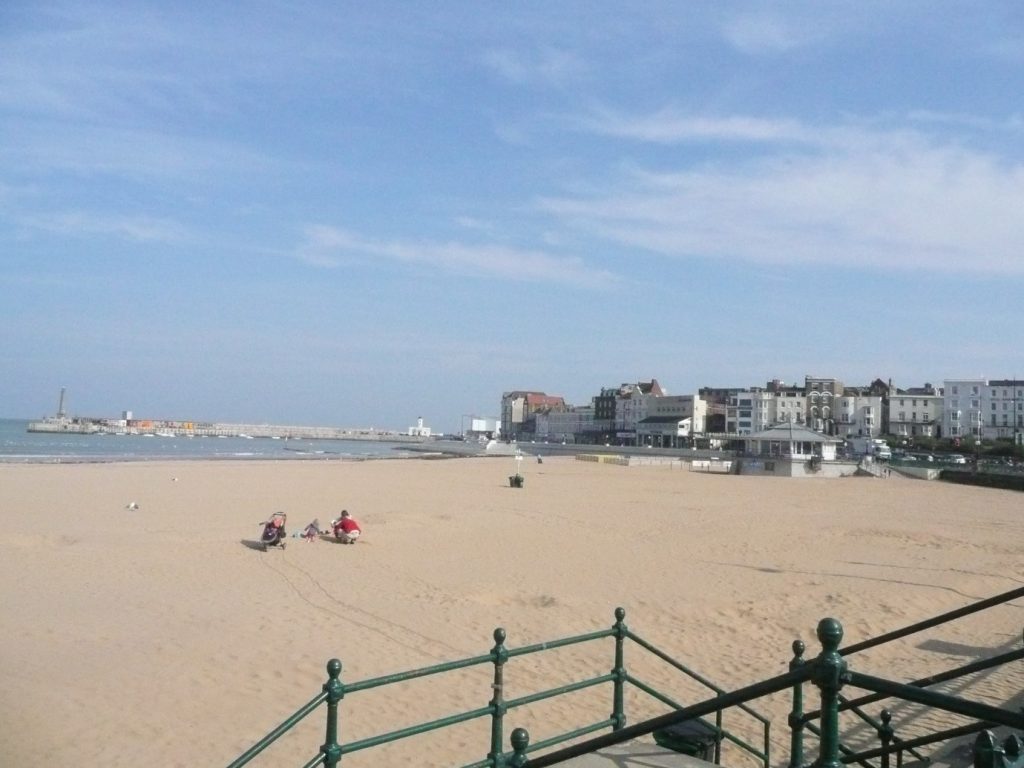Who named Margate “Margate”?
I only visited Margate, Kent, UK, in September 2013 because I live in Margate, Tasmania, and because a “Great Train Journey” from Penzance in Cornwall along the length of the English South Coast logically would end there. Expecting a run-down coastal resort deserted by the British for Spain to my surprise I found a wide sandy beach, friendly locals and an “Old Town” well-preserved and full of character with its pubs, cafes, churches, antique and book shops looking loved and well patronised! Sadly, the local history museum in the old Town Hall only opens 3 days a week, not including the days when I was there, but there was much more to look at than I could manage in two half-days.
Margate, by the way, was so named because of the “mere” or inland “sea” which almost cut off the Isle of Thanet, where it is situated with Ramsgate and Broadstairs, from the rest of Kent at high tide. So in medieval times it was known as “Meregate”, the “-gate” suffix being Norse (“Viking”) for street or road.
I told several locals about Margate, Tasmania. Only one knew we had a Margate, but all seemed very interested. No-one asked how it came to be named after their town but it got me thinking! On my return home I set about trying to find out.
The obvious first stop was my copy of Peter MacFie’s recent publication A History of North West Bay & Margate. The district of North West Baygrew up around the body of water given that name by D’Entrecasteaux from the early 1800s. Margate was gazetted as a town ship in 1866 (p. 32) but had been known by that name for at least a decade. MacFie’s earliest reference to the name “Margate” comes in extracts from the writings of one James Calder, surveyor, who wrote in the cynical but entertaining style of a 19th century Bill Bryson. Calder, passing through in 1855, said that “the designation [of the ‘general stores’] like the name of the hamlet itself – Margate – has been prematurely assumed.” (p. 35) Richard Hall, another surveyor, also used the name Margate in his 1857 map reproduced as Map 11 in MacFie.

Margate, Kent, October 1st 2013
Next logical stop was the Channel Heritage Centre. There I found a copy of the 1856 Valuation Roll for Kingston to North West Bay. Nine properties were specifically listed as being in Margate, belonging to Henry John Allen, Richard Bloomfield, Richard and John Groombridge, Richard Lucas and William Worsley. (Folder “Did your ancestors live in the Channel?”)
Did one of these gentlemen come from Margate, Kent? I looked for the respective families in Ian Lawless’s collection of family trees, discovered that the Worsleys came from Salford, near Manchester, the Lucases (probably) from Plymouth, and Messrs’ Allen and Bloomfield were not represented. However, the Groombridges hailed from West Farleigh, Kent! Near Margate? No, sadly not that easy – West Farleigh is near Maidstone, about 60 km from Margate.
I made use of the CHC’s database to see if there were any documents in other folders that could shed further light, but although there are numerous references to Groombridge, Lucas and Worsley, none pre-date 1856.
So, that’s the story so far – there is medium-strength circumstantial evidence that Richard Smart Groombridge, blacksmith, born 1808 in Kent, transported for stealing a watch in 1830 but made good to the extent of becoming the licensee of the Half Way House Inn at Margate by 1855, may have named Margate, perhaps fondly recalling a childhood holiday at the seaside resort of the same name. Any contributions?
David Tulip
